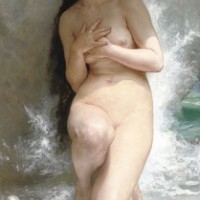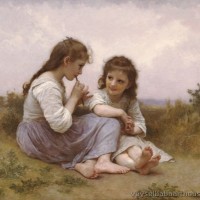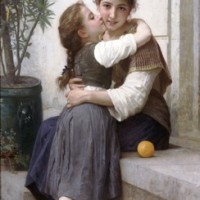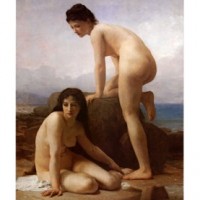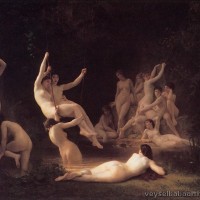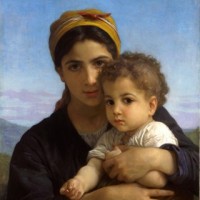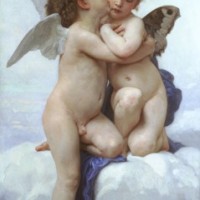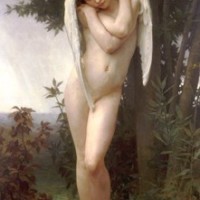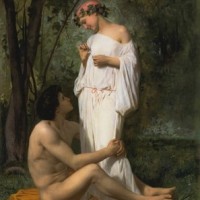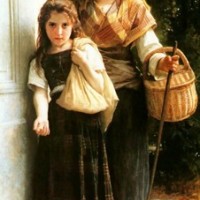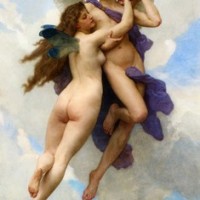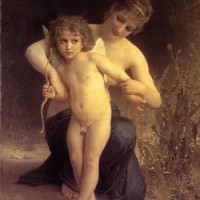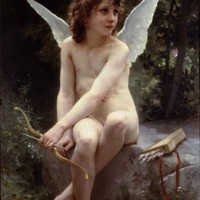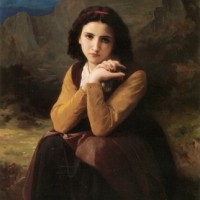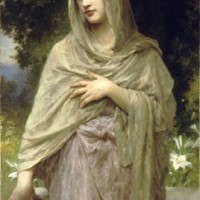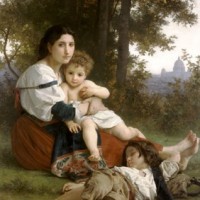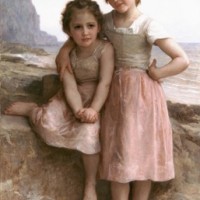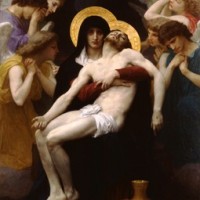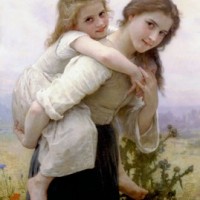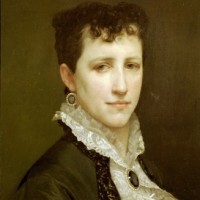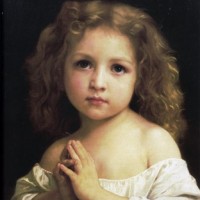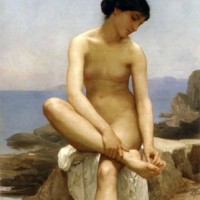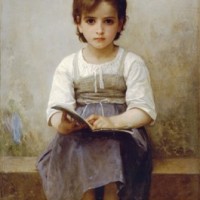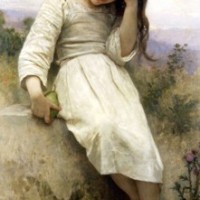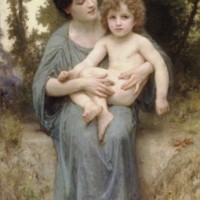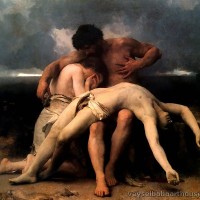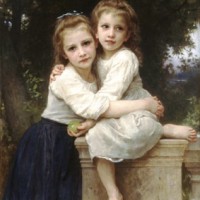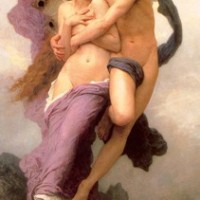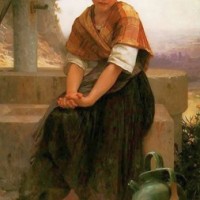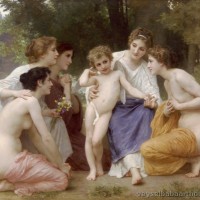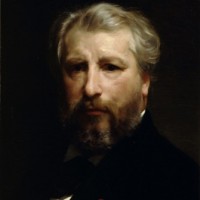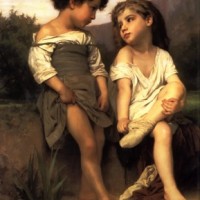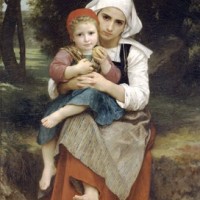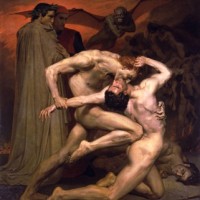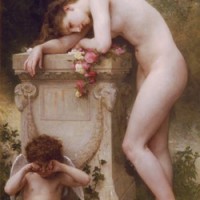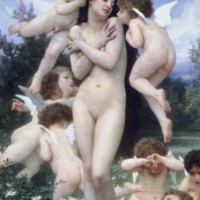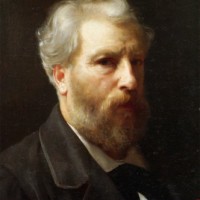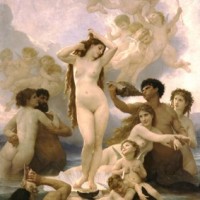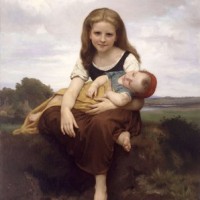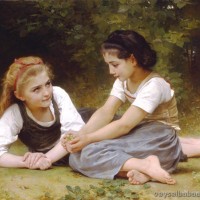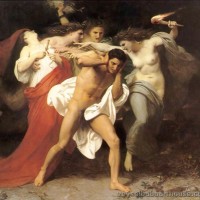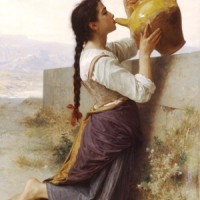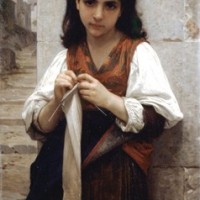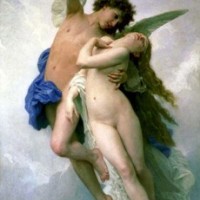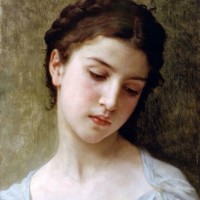- Home
- ABOUT US
- ABOUT VEYSEL BABA
- REDFOX ART HOUSE VIRTUAL TOUR
- MY LAST WILL TESTAMENT
- NOTES ON HUMANITY AND LIFE
- HUMAN BEING IS LIKE A PUZZLE WITH CONTRADICTIONS
- I HAVE A WISH ON BEHALF OF THE HUMANITY
- WE ARE VERY EXHAUSTED AS THE DOOMSDAY IS CLOSER
- NO ROAD IS LONG WITH GOOD COMPANY
- THE ROAD TO A FRIENDS HOUSE IS NEVER LONG
- MY DREAMS 1
- MY DREAMS 2
- GOLDEN WORDS ABOUT POLITICS
- GOLDEN WORDS ABOUT LOVE
- GOLDEN WORDS ABOUT LIFE
- GOLDEN WORDS ABOUT DEATH
- VEYSEL BABA ART WORKS
- SHOREDITCH PARK STORIES
- EXAMPLE LIVES
- ART GALLERY
- BOOK GALLERY
- MUSIC GALLERY
- MOVIE GALLERY
- Featured Article
- Home
- ART GALLERY
- William-Adolphe Bouguereau
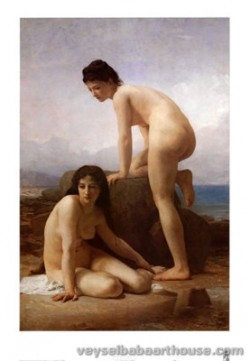
William-Adolphe Bouguereau
William-Adolphe Bouguereau (French pronunciation: [wijam.adɔlf buɡ(ə)ʁo]; November 30, 1825 – August 19, 1905) was a French academic painter and traditionalist. In his realistic genre paintings he used mythological themes, making modern interpretations of classical subjects, with an emphasis on the female human body.[1] During his life he enjoyed significant popularity in France and the United States, was given numerous official honors, and received top prices for his work.[2] As the quintessential salon painter of his generation, he was reviled by the Impressionist avant-garde.[2] By the early twentieth century, Bouguereau and his art fell out of favor with the public, due in part to changing tastes.[2] In the 1980s, a revival of interest in figure painting led to a rediscovery of Bouguereau and his work.[2] Throughout the course of his life, Bouguereau executed 822 known finished paintings, although the whereabouts of many are still unknown.[3]
Life and career
Formative years
William-Adolphe Bouguereau was born in La Rochelle, France, on November 30, 1825, into a family of wine and olive oil merchants.[4] The son of Théodore Bouguereau (born 1800) and Marie Bonnin (1804), known as Adeline, William was brought up a Catholic. He had an older brother, Alfred, and a younger sister, Marie (known as Hanna), who died when she was seven. The family moved to Saint-Martin-de-Ré in 1832. Another sibling was born in 1834, Kitty. At 12 the boy went to Mortagne to stay with his uncle Eugène, a priest, and developed a love of nature, religion and literature. In 1839 he was sent to study the priesthood at a Catholic college in Pons. Here he was taught to draw and paint by Louis Sage who had studied under Ingres. William reluctantly left his studies to return to his family, now residing in Bordeaux. Here the boy met a local artist, Charles Marionneau, and commenced at the Municipal School of Drawing and Painting in November, 1841. William also worked as a shop assistant, hand-colouring lithographs and making small paintings that were reproduced using chromolithography. He was soon the best pupil in his class and decided to become an artist in Paris. To fund the move, he sold portraits - 33 oils in three months. All were unsigned and only one has been traced. He arrived in Paris aged 20 in March 1846.[5]

Bouguereau became a student at the École des Beaux-Arts.[4] To supplement his formal training in drawing, he attended anatomical dissections and studied historical costumes and archeology. He was admitted to the studio of François-Édouard Picot, where he studied painting in the academic style. Academic painting placed the highest status on historical and mythological subjects and Bouguereau won the coveted Prix de Rome at age 26 in 1850,[7] with his Zenobia Found by Shepherds on the Banks of the Araxes.[8] His reward was a three-year residence at the Villa Medici in Rome, Italy, where in addition to formal lessons he was able to study first-hand the Renaissance artists and their masterpieces, as well as Greek, Etruscan, and Roman antiquities.[7] He also studied classical literature, which influenced his subject choice for the rest of his career.[7]
Villa Medici, Rome 1851–54
In April 1848 the young artist entered the Prix de Rome contest. Soon after work began there were riots in Paris and Bouguereau enrolled in the National Guard. After an unsuccessful attempt to win the prize, he entered again in 1849. Following 106 days of competition he again failed to win. His third attempt commenced in April 1850 and five months later he heard he had won a joint first prize. Along with other category winners, William set off for Rome in December and finally arrived at the Villa Medici in January 1851. He explored the city, making sketches and watercolours as he went. He walked to Naples and on to Capri, Amalfi and Pompeii. Still based in Rome and working hard on course work there were more explorations of Italy in 1852. Although the artist bore a strong admiration for all traditional art, he particularly revered Greek sculpture, Leonardo da Vinci, Raphael, Michelangelo, Titian, Rubens and Delacroix. In April 1854 he left Rome and returned to La Rochelle.[9]
Height of career

Bouguereau, painting within the traditional academic style, exhibited at the annual exhibitions of the Paris Salon for his entire working life. An early reviewer stated, "M. Bouguereau has a natural instinct and knowledge of contour. The eurythmie of the human body preoccupies him, and in recalling the happy results which, in this genre, the ancients and the artists of the sixteenth century arrived at, one can only congratulate M. Bouguereau in attempting to follow in their footsteps ... Raphael was inspired by the ancients ... and no one accused him of not being original."[10]
Raphael was a favorite of Bouguereau and he took this review as a high compliment. He had fulfilled one of the requirements of the Prix de Rome by completing an old-master copy of Raphael’s The Triumph of Galatea. In many of his works, he followed the same classical approach to composition, form, and subject matter.[11] Bouguereau's graceful portraits of women were considered very charming, partly because he could beautify a sitter while also retaining her likeness.
Although Bouguereau spent most of his life in Paris, he returned to La Rochelle again and again throughout his professional life. He was revered in the town of his birth, and undertook decorating commissions from local citizens. From the early 1870s William and his family spent every summer in La Rochelle. In 1882 he decided that rather than rent, he would purchase a house, as well as local farm buildings. By August 1882 the family's permanent summer base was on the rue Verdière. The artist would commence several paintings here and complete them in his Paris studio. He died in the town of his birth.[12]
By the late 1850s, he had made strong connections with art dealers, particularly Paul Durand-Ruel (later the champion of the Impressionists), who helped clients buy paintings from artists who exhibited at the Salons.[13] Thanks to Paul Durand-Ruel, Bouguereau met Hugues Merle, who later often was compared to Bouguereau. The Salons annually drew over 300,000 people, providing valuable exposure to exhibited artists.[14] Bouguereau’s fame extended to England by the 1860s, and he bought a large house and studio in Montparnasse with his growing income.[15]
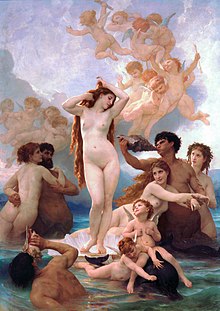
Bouguereau was a staunch traditionalist whose genre paintings and mythological themes were modern interpretations of Classical subjects, both pagan and Christian, with a concentration on the naked female form. The idealized world of his paintings brought to life goddesses, nymphs, bathers, shepherdesses, and madonnas in a way that appealed to wealthy art patrons of the era.
Bouguereau employed traditional methods of working up a painting, including detailed pencil studies and oil sketches, and his careful method resulted in a pleasing and accurate rendering of the human form. His painting of skin, hands, and feet was particularly admired.[16]He also used some of the religious and erotic symbolism of the Old Masters, such as the "broken pitcher" which connoted lost innocence.[17]
Bouguereau received many commissions to decorate private houses, public buildings, and churches, and, early on, this added to his prestige and fame. As was typical of such commissions, Bouguereau would sometimes paint in his own style, and at other times conform to an existing group style. He also made reductions of his public paintings for sale to patrons, of which The Annunciation (1888) is an example.[18] He was also a successful portrait painter and many of his paintings of wealthy patrons remain in private hands.[19]
Académie Julian
From the 1860s, Bouguereau was closely associated with the Académie Julian where he gave lessons and advice to art students, male and female, from around the world. During several decades he taught drawing and painting to hundreds, if not thousands, of students. Many of them managed to establish artistic careers in their own countries, sometimes following his academic style, and in other cases, rebelling against it, like Henri Matisse. He married his most famous pupil, Elizabeth Jane Gardner, after the death of his first wife.
Bouguereau received many honors from the Academy: he became a Life Member in 1876; received the Grand Medal of Honor in 1885;[20] was appointed Commander of the Legion of Honor in 1885; and was made Grand Officier of the Legion of Honor in 1905.[21] He began to teach drawing at the Académie Julian[22] in 1875, a co-ed art institution independent of the École des Beaux-Arts, with no entrance exams and nominal fees.[23]
Wives and children

In 1856, William began living with one of his models, Nelly Monchablon, a 19-year-old from Lisle-en-Rigault. Living together out of wedlock, the pair kept their liaison a secret. Their first child, Henriette, was born in April 1857. Georges was born January 1859. A third child, Jeanne, was born December 25, 1861. The couple married quietly (for many assumed they were already wed) on May 24, 1866. Eight days later, Jeanne died from tuberculosis. In mourning, the couple went to La Rochelle, and Bouguereau made a painting of her in 1868. A fourth child, Adolphe (known as Paul), was born in October 1868. Aged 15, Georges' health suffered, and his mother took him away from the bad air of Paris. He died, however, on June 19, 1875. Nelly had a fifth child in 1876, Maurice, but her health was declining and the doctors suspected that she had contracted tuberculosis. His wife died on April 3, 1877, and baby Maurice died two months later.[24]
The artist planned to marry Elizabeth Jane Gardner, a pupil whom he had known for ten years, but his mother was opposed to the idea. Soon after Nelly's death, she made William swear he would not remarry within her lifetime. After his mother's death, and after a nineteen-year engagement, William and Elizabeth married in Paris in June 1896.[25] His wife continued to work as his private secretary and helped to organize the household staff. Tragically, his son Paul contracted tuberculosis in early 1899 and he, William, and his stepmother, went to Menton in the south. When the stay prolonged, William found a room in which to paint. Paul died at his father's house in April 1900 aged 32. William had outlived four of his five children. Elizabeth was with William to the end. She died in Paris in January 1922.[26]
Later years and death
Bouguereau was an assiduous painter. Even during the twilight years of his life, he would rise at dawn to work on his paintings six days a week and would continue painting until nightfall.[27] Throughout the course of his lifetime, he is known to have painted at least 822 paintings. Unfortunately, many of these paintings have been lost.[3] Near the end of his life he described his love of his art: "Each day I go to my studio full of joy; in the evening when obliged to stop because of darkness I can scarcely wait for the next morning to come ... if I cannot give myself to my dear painting I am miserable."[28]
In the spring of 1905, Bouguereau's house and studio in Paris were burgled. On August 19, 1905, Bouguereau died in La Rochelle at the age of 79 from heart disease.
